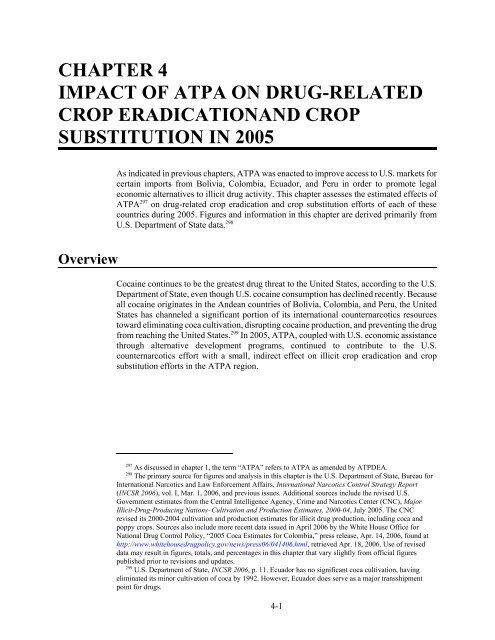The Impact of the Andean Trade Preference Act Twelfth ... - USITC
The Impact of the Andean Trade Preference Act Twelfth ... - USITC
The Impact of the Andean Trade Preference Act Twelfth ... - USITC
- No tags were found...
You also want an ePaper? Increase the reach of your titles
YUMPU automatically turns print PDFs into web optimized ePapers that Google loves.
CHAPTER 4IMPACT OF ATPA ON DRUG-RELATEDCROP ERADICATIONAND CROPSUBSTITUTION IN 2005As indicated in previous chapters, ATPA was enacted to improve access to U.S. markets forcertain imports from Bolivia, Colombia, Ecuador, and Peru in order to promote legaleconomic alternatives to illicit drug activity. This chapter assesses <strong>the</strong> estimated effects <strong>of</strong>ATPA 297 on drug-related crop eradication and crop substitution efforts <strong>of</strong> each <strong>of</strong> <strong>the</strong>secountries during 2005. Figures and information in this chapter are derived primarily fromU.S. Department <strong>of</strong> State data. 298OverviewCocaine continues to be <strong>the</strong> greatest drug threat to <strong>the</strong> United States, according to <strong>the</strong> U.S.Department <strong>of</strong> State, even though U.S. cocaine consumption has declined recently. Becauseall cocaine originates in <strong>the</strong> <strong>Andean</strong> countries <strong>of</strong> Bolivia, Colombia, and Peru, <strong>the</strong> UnitedStates has channeled a significant portion <strong>of</strong> its international counternarcotics resourcestoward eliminating coca cultivation, disrupting cocaine production, and preventing <strong>the</strong> drugfrom reaching <strong>the</strong> United States. 299 In 2005, ATPA, coupled with U.S. economic assistancethrough alternative development programs, continued to contribute to <strong>the</strong> U.S.counternarcotics effort with a small, indirect effect on illicit crop eradication and cropsubstitution efforts in <strong>the</strong> ATPA region.297 As discussed in chapter 1, <strong>the</strong> term “ATPA” refers to ATPA as amended by ATPDEA.298 <strong>The</strong> primary source for figures and analysis in this chapter is <strong>the</strong> U.S. Department <strong>of</strong> State, Bureau forInternational Narcotics and Law Enforcement Affairs, International Narcotics Control Strategy Report(INCSR 2006), vol. I, Mar. 1, 2006, and previous issues. Additional sources include <strong>the</strong> revised U.S.Government estimates from <strong>the</strong> Central Intelligence Agency, Crime and Narcotics Center (CNC), MajorIllicit-Drug-Producing Nations–Cultivation and Production Estimates, 2000-04, July 2005. <strong>The</strong> CNCrevised its 2000-2004 cultivation and production estimates for illicit drug production, including coca andpoppy crops. Sources also include more recent data issued in April 2006 by <strong>the</strong> White House Office forNational Drug Control Policy, “2005 Coca Estimates for Colombia,” press release, Apr. 14, 2006, found athttp://www.whitehousedrugpolicy.gov/news/press06/041406.html, retrieved Apr. 18, 2006. Use <strong>of</strong> reviseddata may result in figures, totals, and percentages in this chapter that vary slightly from <strong>of</strong>ficial figurespublished prior to revisions and updates.299U.S. Department <strong>of</strong> State, INCSR 2006, p. 11. Ecuador has no significant coca cultivation, havingeliminated its minor cultivation <strong>of</strong> coca by 1992. However, Ecuador does serve as a major transshipmentpoint for drugs.4-1
















